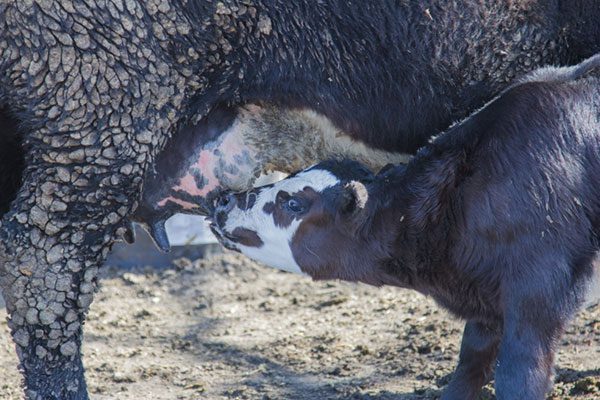TMR feeding can improve calf growth and reproductive performance by:
- eliminating the negative effects of feed selection and between-animal competition that occur when forages are fed free choice, and
- allowing one to more easily and accurately meet the nutritional requirements of individual cows at each stage of productions
Importance of meeting beef cow nutritional requirements: It has been reported that up to 80 percent of the variability in calf weaning weights is due to differences in milk production between dams. One of the strongest determinants of the ability of a dam to reach her milk production potential, and thus maximize calf growth, is the nutrition she receives during the last trimester of pregnancy and subsequently during calving and early lactation.
This was elegantly demonstrated in the early 1990s by researchers from Purdue University, as well as others, by comparing the effects of feeding diets that met the energy requirements of beef cows with those that were deficient, both pre- and post-calving. In short, feeding diets that were 30% deficient in energy, either before or after calving, decreased calf birth weight by close to 12 pounds, decreased calf growth by up to 64 lbs. (16.1%) and decreased the proportion of cows in estrus within 60 days after calving from about 56% to 33%. This demonstrates how not meeting the nutritional requirements of beef cows can substantially impair calf growth for the current year, and at the same time reduce reproductive performance for the following year.
Table: Comparison of the dietary requirements of beef cows post-weaning, during mid-gestation (Non-lactating) versus post-calving, during early lactation (Lactation).
| Stage of production | Non-lactating1 | Lactating2 |
| Dry matter intake (lbs./day, max.) | 25.5 | 30.9 |
| Crude protein (% DM) | 8 | 11 |
| Forage NDF (% DM) | 62 | 39 |
| TDN (% DM) | 54 | 64 |
| Calcium (% DM) | 0.17 | 0.37 |
| Phosphorus (% DM) | 0.12 | 0.22 |
1 Dry beef cow: 1250 lbs., weaned calf, mid gestation, above 32o F.
2 Lactating beef cow: 1250 lbs., 4th calf, not pregnant, 25 lbs. peak milk production, 30 days lactation, 15o F.
Free-choice feeding of forages, and feed selection, increase the incidence of nutritional deficiencies: We discussed in our previous article how feed selection by cows fed forages free choice helps them meet their nutritional requirements, and is dependent on feed wastage. In these cases, if forage availability is restricted to minimize waste, competition between animals will result in a significant proportion of the herd failing to meet their nutritional requirements and result in less than optimal calf growth and reproductive efficiency.
Here is how it works: Assume adequate amounts of forage are fed free choice, with an appropriate nutritional composition for a given stage of production, as outlined in the Table. Larger, more mature and dominant cows out-compete the younger heifers, and thinner, weaker, older and or more timid cows for the higher quality components of the forage. This does two things: 1) dominant cows get more nutrients than they require and gain excessive weight, and, if these occur pre-calving, they can experience problems with dystocia (hard calving) and reduced milk production, and 2) remaining cows receive a diet that will be by difference deficient in both energy and protein resulting in excessive body weight loss prior to calving, weak calf syndrome, poor milk production, and decreased calf growth and reproductive efficiency. In practice, we observe increased variability in cow body condition, calf body weight at weaning, and either poor pregnancy rates or an increased calving interval, all of which can be minimized by ensuring each animal has the opportunity to meet its nutritional requirement by feeding a TMR.
Benefits of a TMR for improving cow-calf performance: The nutritional requirements of beef cows vary with age (e.g. heifer versus mature cow), stage of production, and potential milk production. Nutritional requirements are also complex, and include consideration of animal intake capacity, dietary and energy, protein and mineral content (see Table). Thus, it is very difficult to meet the specific nutrient requirements and production potential of all animals when forages and minerals are fed free choice, and supplemental energy (e.g. grain) and/or protein sources are top-dressed due to selection and competition.
The benefits of TMR feeding and optimal production are realized by:
- formulating a ration whose concentrations meet the requirements of all classes of animals to be fed,
- creating a TMR by placing all the ingredients (except perhaps trace mineralized salt) into a mixer that is capable of processing (if necessary) and mixing all the ingredients into a uniform mix that resists sorting, and
- feeding the TMR in such a way that all animals have the opportunity to consume their share of the ration.
When working with baled forages, a vertical mixer capable of rapidly processing intact bales into a TMR, such as the Jaylor TMR mixer, is ideal. In this way, forages can be selected, processed and fed waste free based on how well they match the nutritional requirements of a given group of animals and their stage of production or growth, blended with other forages to better balance the forage composition as needed, and/or supplemented with inexpensive sources of grains, byproducts, proteins and minerals to optimize milk production, calf growth and reproductive performance. Field results indicate that feeding forages, and meeting nutritional requirements using a vertical TMR mixer can conservatively increase annual weaned calf production by 10 to 15 percent, as compared with traditional feeding methods, over and above the simultaneous reduction in feed wastage.
Editor’s note: this article first appeared in the April 2014 issues of American Cattlemen magazine. It has been updated for accuracy and completeness.



